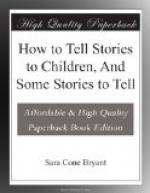This time the little audience settled to attention almost at the opening words. After about five minutes I was suddenly conscious of a sense of ease and relief, a familiar restful feeling in the atmosphere; and then, at last, I knew that my audience was “with me,” that they and I were interacting without obstruction. Absolutely quiet, entirely unconscious of themselves, the boys and girls were responding to every turn of the narrative as easily and readily as any group of story-bred kindergarten children. From then on we had a good time together.
The process which took place in that small audience was a condensed example of what one may expect in habitual story-telling to a group of children. Once having had the attention chained by crude force of interest, the children begin to expect something interesting from the teacher, and to wait for it. And having been led step by step from one grade of a logical sequence to another, their minds—at first beguiled by the fascination of the steps—glide into the habit of following any logical sequence. My club formed its habit, as far as I was concerned, all in one session; the ordinary demands of school procedure lengthen the process, but the result is equally sure. By the end of a week in which the children have listened happily to a story every day, the habit of listening and deducing has been formed, and the expectation of pleasantness is connected with the opening of the teacher’s lips.
These two benefits are well worth the trouble they cost, and for these two, at least, any teacher who tells a story well may confidently look—the quick gaining of a confidential relation with the children, and the gradual development of concentration and interested attention in them.
These are direct and somewhat clearly discernible results, comfortably placed in a near future. There are other aims, reaching on into the far, slow modes of psychological growth, which must equally determine the choice of the story-teller’s material and inform the spirit of her work. These other, less immediately attainable ends, I wish now to consider in relation to the different types of story by which they are severally best served.
First, unbidden claimant of attention, comes
THE FAIRY STORY
No one can think of a child and a story, without thinking of the fairy tale. Is this, as some would have us believe, a bad habit of an ignorant old world? Or can the Fairy Tale justify her popularity with truly edifying and educational results? Is she a proper person to introduce here, and what are her titles to merit?




